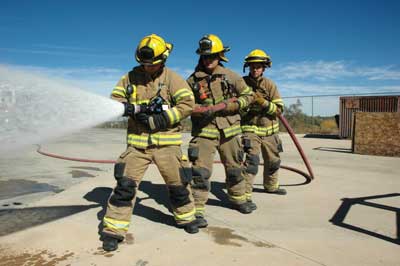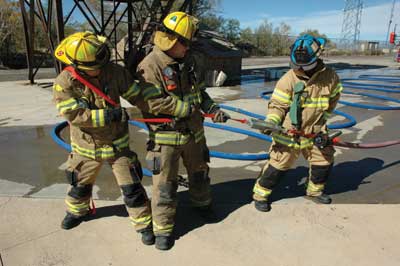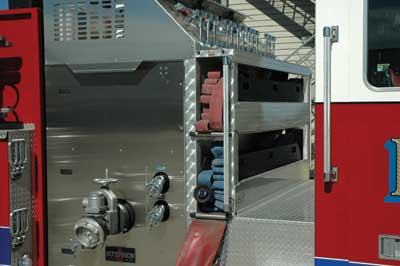BY BILL NEMICK
Just about anyone you talk to in the fire service will tell you that you need a 2½-inch line for an interior attack in a commercial building fire. In the past, this was the best option to deliver the quantity of water needed to fight such a fire, but with significant improvements in firefighting hose, a 2½-inch hose may not always be the best option. One of the many hose design improvements over the years drastically reduces friction loss, making it possible to flow more water from any given size hoseline other than what most firefighters are accustomed to. With this ability to flow more water from the same size hoseline, we need to ask the following questions:
What if a 1¾-inch hoseline
- —could easily flow 250 gallons per minute (gpm)?
- —was actually more flexible than a 2½-inch line?
- —was much easier and faster to deploy?
- —needed fewer firefighters to deploy?
If all of the above were true, would you consider taking this 1¾-inch line into a commercial structure for an interior attack? Are you open-minded and objective enough to consider the possibilities? Before you start explaining why a 1¾-inch line is a poor choice for an interior attack line at a large fire, read the information below and give it a chance.
I realize that the ingrained protocol for many firefighters is to use a 1¾-inch line for residential fires and a 2½-inch line for commercial fires. The issue I have with following this protocol is that the size of the fire is determining the size of the hoseline needed instead of the size of the fire determining the amount of water needed. When researching this topic, I was amazed when some firefighters didn’t know how much water could and does flow through various hoseline systems. Then it hit me: Maybe this rule-of-thumb attitude is one of those “traditions” that we follow without fully understanding why.
To further my understanding, I asked some firefighters specifically how many gpm they expected out of a 1¾-inch and a 2½-inch handline in an interior attack situation. The general response of those firefighters was that a 1¾-inch and a 2½-inch handline could flow about 150 gpm and 250 gpm, respectively. This convinced me that, at least in today’s world, specifying the hose size may be a little too simplistic and a better understanding of hydraulics and technology is needed to fully assess how much water can be delivered through various hoseline systems.
 |
| (1) Flowing 250 gpm through the low-friction/high-flow 1¾-inch hose. (Photos by author.) |
When I first heard of a low-friction, 1¾-inch hose claiming a friction loss that is half of a conventional 1¾-inch hose capable of flowing 250 gpm, I disregarded it as an overblown sales pitch. My prior experience with traditional 1¾-inch line offered evidence that it couldn’t come close to flowing 250 gpm, but the potential benefits of this touted ability piqued my curiosity and I decided to do a little investigating. The first thing I did was to test this hose myself in my own way at my own training facility. Surprisingly, I was able to flow the advertised 250 gpm! Now my curiosity had really piqued: If a 1¾-inch line could flow 250 gpm, then why use a 2½-inch interior attack line? If this hose could deliver on its promise, it would mean that our standard 1¾-inch preconnected lines could be used at a small shed fire, a house fire, or even a commercial fire. This low-friction/high-flow hose would simplify the choice of which hoseline to use, require fewer firefighters to deploy, deploy more quickly, and still provide all of the water traditionally expected from a single 2½-inch handline. This 1¾-inch hose’s abilities seemed too good to be true, and I felt compelled to investigate further.
I recognized that to extinguish a fire, physics requires a certain amount of water to overcome a certain amount of heat produced by that fire. I also recognized that the volume of water alone wasn’t the only important factor when extinguishing a fire. Other factors are involved that need to be addressed to ensure this hose delivers water effectively and in a user-friendly manner that is a practical choice for firefighters. To find out what other qualities were needed of this hose, I asked a number of firefighters from across the country what their thoughts were on this concept. At a major fire conference last year, I quizzed a number of firefighters about their policies on deploying 2½-inch interior attack lines. As expected, most of the firefighters stated that they deployed 2½-inch interior attack lines for large or commercial fires in which they normally expected a flow of 250 gpm from each handline. I then asked their opinions on the possibility of flowing 250 gpm from a 1¾-inch attack line instead of a 2½-inch attack line. Except for one battalion chief from a very large department, everybody I asked didn’t think a 1¾-inch line was a viable option for these conditions. This is where some of the conversations became interesting. By playing devil’s advocate, I continued to press many of the firefighters for their reasons against using this hose in this capacity and didn’t stop until they gave me reasonable concerns that needed to be addressed.
 |
| (2) At left, 200 feet of traditional 2½-inch hose at 100 psi. At right, 200 feet of 1¾-inch low-friction/high-flow hose at 250 psi. Both hoses are as compact as possible without severe kinking. Note the much smaller bend radius for the 1¾-inch hose without kinking compared with the 2½-inch hose, which is already slightly kinked. Thus, the 1¾-inch hose would not be too stiff to advance through a building. |
TESTING
Below are several objections firefighters raised regarding using a 1¾-inch line flowing 250 gpm for an interior attack line at a large fire. I investigated each concern as objectively and as scientifically as I could, using the tools at my disposal. Below are my findings.
1. A 1¾-inch line cannot flow 250 gpm at a reasonable engine pressure. I ran a number of flow tests using 200 feet of this 1¾-inch, low-friction/high-gpm hose with smooth bore and dual pressure automatic nozzles (100 psi or 55 psi) at incremental flows from 130 gpm up to and including 300 gpm. I used a flow meter along with a pitot gauge (to verify the measured flow and discharge pressure when using smooth bore nozzles). I also used two inline gauges to measure friction loss, one at the beginning of the hose and one at the nozzle.
The result closely reflected the manufacturer’s published figures for friction loss. I confirmed that when flowing 250 gpm through 200 feet of this 1¾-inch hose, we had a friction loss of about 50 psi per 100 feet. This means that a 11⁄8-inch smooth bore nozzle with a nozzle pressure of 50 psi would require a discharge pressure (DP) of about 150 psi for a 200-foot length. Automatic nozzles need a DP of either 200 psi or 180 psi, depending on what the dual-pressure nozzle was set at. (The nozzle used had a capacity of 225 gpm at the 55 psi setting, requiring us to “overpressure” the nozzle to achieve 250 gpm. This would be the case regardless of the hose size.)Obviously, any and all of these DPs are easily obtainable and, although they are higher than that of a 2½-inch line, what does the higher DP hurt? I believe that, when possible, we should let the pumper do the extra work instead of burdening the firefighters with it!
 |
| (3) Measuring the force needed to drag hose using a hanging weight scale. |
2. The hoseline will be so stiff at the required pressure that you won’t be able to bend it around corners and still easily advance the hose. It would be like trying to advance a long wooden 4 × 4 through the building.
False. After performing numerous experiments with both 1¾-inch and 2½-inch charged hoselines, I can conclude without a doubt that the 1¾-inch line is much easier to advance. I performed several tests with the 1¾-inch line charged at 250-psi static and the 2½-inch line at 100-psi static, and in every case the 2½-inch line required almost double the force to advance. This doubling in force seems to closely correlate with the weight of the charged hoselines. The water in a 50-foot section of this 1¾-inch hose weighs about 52 pounds, whereas the water in a 50-foot section of 2½-inch hose weighs about 106 pounds.
I also found it interesting that when we incrementally increased the static pressure in the 1¾-inch hose from 150 psi to 250 psi, we could not detect a significant increase in difficulty when advancing the hose.
 |
| (4) Two 200-foot speedlays of low-friction/high-flow 1¾-inch hose. |
3. The nozzle reaction will be more than that for a 2½-inch line and, therefore, make it impractical for firefighters to handle.
False. The nozzle reaction will be practically the same with either a 2½-inch or a 1¾-inch hoseline as long as the flow is the same and identical nozzles are used. Nozzle reaction is primarily a function of nozzle pressure and gpm; hoseline size has little or nothing to do with it.
It is important to note that any handline flowing 250 gpm creates a considerable nozzle reaction and adequate personnel are needed to safely control these handlines. Using this 1¾-inch hose does not reduce the number of firefighters needed at the nozzle to counteract the nozzle reaction.
4. The hose at the nozzle will be too stiff to allow the nozzle operator to sweep the nozzle effectively.
False. Once again, all things being equal, the nozzle pressures will be identical in both the 1¾- and 2½-inch hoselines. This means that the residual pressure in the hose directly behind the flowing nozzle will also be the same; therefore, the 1¾-inch line can’t be stiffer than the 2½-inch line. The discharge pressure will be higher for the 1¾-inch line, but this initially higher residual pressure will incrementally drop until it reaches the nozzle and then equal that of a 2½-inch line. Once at the nozzle, the residual pressure will have to be the same as in a 2½-inch line to flow equal amounts of water.
5. If firefighters train enough, they can become very good at advancing a 2½-inch attack line.
Although this statement is true, it is irrelevant to this discussion because if the same amount of training were invested into advancing this 1¾-inch line, the proficiency with the 1¾-inch line would also increase and still result in a much faster deployment time than with a 2½-inch line.
6. With a 2½-inch line you have the option of flowing 325 gpm.
True. In fact, it is reasonable to flow 500 gpm or more through a 2½-inch line, but do we really need or want a hand-line with this much capacity? If we do want the capability to flow more than 250 gpm, can our firefighting teams really handle the extra burden of advancing and using such a line? And if they can, should our firefighters really be in a building requiring this much water in the first place? This is a question that each department will have to answer on its own, but I’m willing to speculate that only the largest, most heavily staffed departments can safely handle this much water from a single handline.
7. In tall high-rise buildings, every pound of friction loss is important.
Possibly. Fires in high-rise buildings and other unique situations may indeed require the lower friction loss found in 2½-inch hose. These specialty types of fires require each individual department to determine its own particular needs and capabilities.
After firefighters experience this hose’s ability to flow 250 gpm and still advance like the 1¾-inch preconnect that they’re used to, they ask, “How does this hose do it?” I explain that the manufacturer has found a way to eliminate the separate waterproofing hose liner by including it with the inner jacket, thus increasing the hose’s inside diameter by about 1⁄8 inch. I also tell them that there are likely several other factors that are not as obvious that also contribute to this hose’s ability.
TEST DETAILS
- These tests were performed by using a line gauge immediately before the 200 feet of 13/4-inch hose and another line gauge immediately before the nozzle. When flowing 250 gpm, these line gauges indicated a friction loss of nearly 100 psi for 200 feet of hose.
- The preconnect outlet gauge on the pump panel registered a higher pressure than the first line gauge because of the hard plumbing within the pumper. Typically, the outlet pressure is measured immediately after the shutoff valve and doesn’t account for the friction loss in the hard plumbing from the shutoff valve to the actual fitting to which the hose attaches. This differential in pressure varies with each pumper and can be quite significant. I used several different pumpers when testing this hose; when flowing 250 gpm, the outlet gauge pressure was anywhere from 20 to 30 psi higher than the first line gauge at the beginning of the hose, depending on the particular pumper used.
- The gauge measuring the pump discharge pressure also indicated a higher pressure than the preconnect outlet pressure gauge. Once again, this occurred because of where the pressure is measured within the hard plumbing of the pump assembly.
- A reduction in pressure from the pump discharge to the first coupling of any hose is present in all pumpers and should be accounted for in all pumping situations.
- The force needed to advance a charged hoseline was determined by using a weight measuring scale attached between two pieces of webbing. One end of the webbing assembly was attached to the nozzle, and firefighters pulled on the opposite end of the webbing assembly.
- We measured the force needed to advance charged hoselines in open areas, open areas with obstacles, and through occupied buildings. In all cases, the 1¾-inch hose was much easier to advance.
- The hose used was 1½ years old.
RECOMMENDATIONS
- Firefighters must train with this hose so they know what to expect during various firefighting conditions. Use a nozzle that you can quickly adjust to handle different flow volumes up to 250 gpm such as a stacked-tip smooth bore nozzle, a selectable gallonage combination nozzle, or an automatic nozzle.
- I recommend that the outlet discharge pressure (ODP) be standardized to handle the most common fires in a community. Only increase the pressure to produce 250 gpm when the appropriate fireground officer specifically requests you do it. In my department, we use automatic nozzles, and I have recommended that the ODP be 130 psi for all but the largest fires. With this hose/nozzle combination, an ODP of 130 psi allows the nozzle operator to flow anywhere from about 100 to 180 gpm without intervention from the pump operator.
- Determine what the friction loss is from where the discharge outlet gauge measures the pressure to the beginning of the hoseline. As stated earlier, this discrepancy can be significant and varies with each pumper. This discrepancy also increases with increased flow volume.
I have been unable to find a viable reason not to use this low-friction 1¾-inch hose. The research and tests I conducted convinced me that this type of low-friction 1¾-inch hose is an appropriate line to use in most interior attack situations, including many commercial buildings. In fact, I believe this 1¾-inch line is actually preferable to a 2½-inch line because it is much easier to maneuver and faster to deploy. Not only is this hose easier to use, but it also allows us to use the space that the traditional 2½-inch handlines occupied for other uses such as for a 500-gpm single-line ground monitor or an extended length hose assembly.
There are, of course, instances where you should use a 2½-inch interior attack line, such as when using long attack lines or maybe when fighting a fire in a tall high-rise. Other than for these unusual or specialty fires, I can’t see why a department would want its firefighters to wrestle with a 2½-inch line when it’s not necessary.
Experiment with some low-friction 1¾-inch hose and decide for yourself. Maybe there is a fatal flaw, but I sure didn’t find one. Until a fatal flaw is found, I am convinced that, at least for my department, this low-friction 1¾-inch hose is a much better alternative to the traditional 2½-inch hose for most interior attack situations.
What works for one department doesn’t necessarily work for another. Instead of blindly following what other departments do, learn why they do what they do. By understanding why a certain procedure, strategy, or tactic is used, you can then objectively determine how and if it applies to your department. If truly educated firefighters within quality fire departments can’t decide what works best for their community, then who can?
● BILL NEMICK is an assistant chief and a 28-year veteran in the Pueblo (CO) Fire Department, which is a Commission on Fire Accreditation International (CFAI) internationally accredited agency. He has been an adjunct instructor with the Pueblo Community College Fire Science Program and has a bachelor’s degree in industrial arts and science education and an associate degree in fire science.
Fire Engineering Archives

